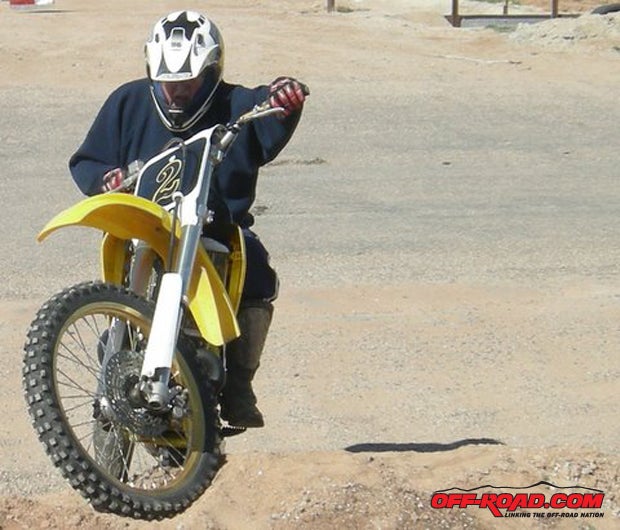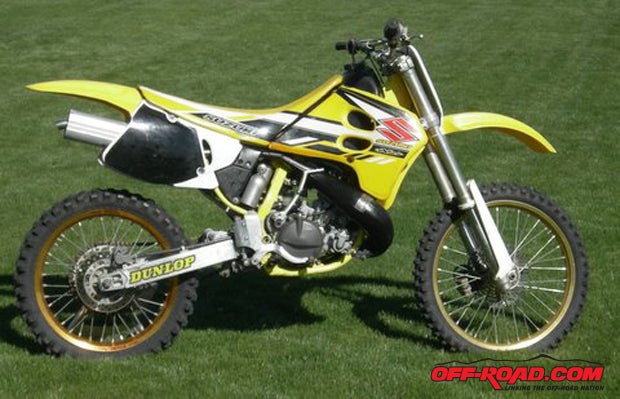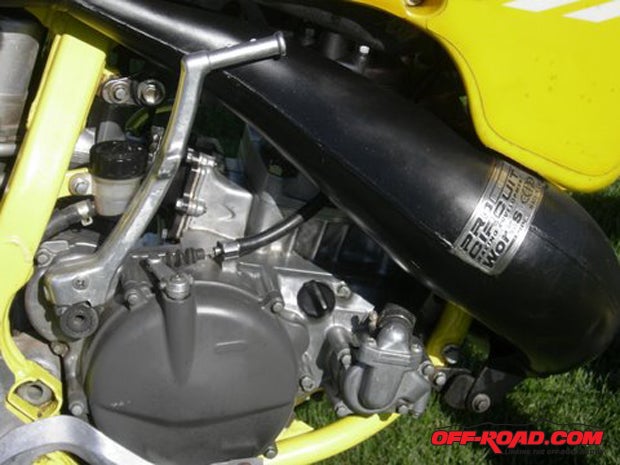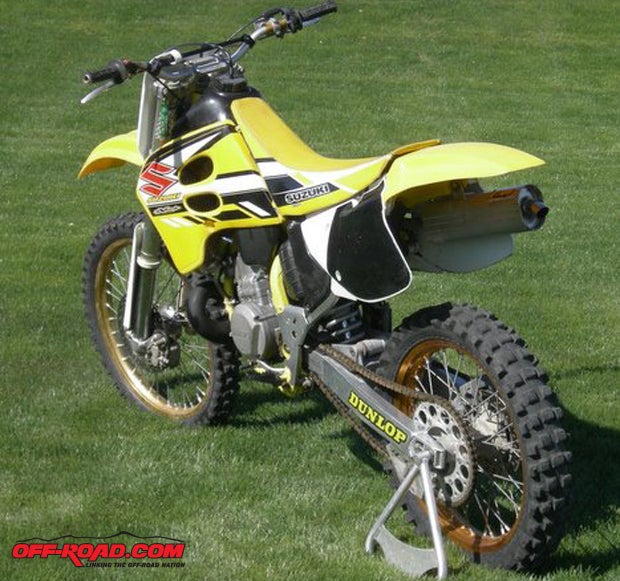
After getting our new 1994 Suzuki RM 250 started and running, we corrected a few minor problems like the leaky carburetor and the weeping gas tank. A bit of epoxy solved the gas tank problem and we replaced the o-ring on the carburetor float bowl. The slobbering of gas all over the engine ceased with these simple fixes.
Finally, we got ready to ride it in the dirt. To refresh our memory, I dragged out a 1994 issue of Dirt Bike magazine on the RM 250 test. In there, we recalled that the motorcycle had an excellent motor, with ferocious midrange and the ability to rev out strongly, but it was a bit soft on low-end power.
Other Project Lowbucks Stories:
Project Lowbucks, Part 5
Project Lowbucks, Part 4
Project Lowbucks, Part 3
Project Lowbucks, Part 2
Project Lowbucks, Part 1

In the 1994 model, the ports were moved around to provide more midrange to top-end power compared to the ‘93, and the piston got another ring for better sealing and life. These mods called for a new pipe, and Suzuki built a low-to-mid pipe for '94. Crank bearings were also strengthened, and the clutch cable was replaced with a heftier unit. The crank relocation also called for new clutch and magneto covers. The RM 250 also received cast footpegs, wider fork protectors, longer-wearing brake pads and narrower radiator shrouds. The clutch is so light that you can one-finger it out of every turn and not get tired. Suzuki removed two clutch plates (one each) from the 250 for '94. The throttle has the lightest pull, and the brakes take a light touch.

Suzuki was the first manufacturer to equip its production motocrossers with works forks. The Twin Chamber Showas are of the same design as Team Honda works components of that era. Materials and finish aren't as good or costly as the works pieces, but the RM forks are reasonable facsimiles. Basically, the cartridge is inverted and isolated from slider contaminants, like a shock within the tubes. The fork has the damping oil being separated from the lubricating oil, like a shock within the fork.

As delivered, the RM is softly sprung and bottoms easily. The cure is to crank the compression clicker in. Shock action is also decent. The RM soaks up the small stutter bumps a lot better than it did on previous Suzukis. Suzuki went for a more linear linkage ratio, and it seems to be better on square-edged stuff at the expense of some bottoming on G-outs.
It will hold the inside line in a corner, but getting the bike to hook up under acceleration is another matter. The RM is long, low and stable in the air, but it headshakes some when coming down from speed over rough ground.

The stock engine lost a bit of its snap off of the very bottom, but it has a smoother midrange thrust and more on top. Notice we said smoother; the RM still has the most midrange of any 250 two-stroke of that time frame and can be a handful on slick tracks. Our bike came with a Pro Circuit pipe that gave a whole lot more end than you would have with a stock RM pipe. In fact, we’d suggest that you install a Pro Circuit pipe on your Ô94 RM 250 if you have one.
RECOMMENDED JETTING:
Suzuki recommends a 172 main, 52 pilot, the standard needle in the second position and 1 1/2 turns out on the airscrew, with a gas/oil mixture of 32:1. Ours came too rich, so we leaned the pilot and main one size (50 and 170).
SUSPENSION SETTINGS:
Standard, the RM fork has a .38 spring, 155mm oil height and clickers at 12/10 out. The shock has a 5.0 spring, 100mm of sag and clickers at 10/12. Average-sized riders will want two clicks more compression on the fork and a click more shock compression. Heavier riders will want 0.40 and 5.2 springs with one click more rebound at each end.
ENGINE TIPS:
You can also pick up some more bottom end by advancing the ignition timing two degrees. With this ignition setting and/or lower gearing, you can pull a higher gear, which unloads the suspension and lets it react to stutter bumps better. THE 
BOTTOM LINE:
All things considered, we must consider Project Lowbucks to be a complete success. We have a total of $243 in the bike. That's it! We checked on the prices of 1994 RM 250 Suzukis and the low blue book price was $1053. On the high-end of the scale, we found the bikes going for about $1500. So there you have it. If you have enough patience and are willing to work some, you could end up with the decent dirt bike for low bucks.

Other Project Lowbucks Stories:
Project Lowbucks, Part 5
Project Lowbucks, Part 4
Project Lowbucks, Part 3
Project Lowbucks, Part 2
Project Lowbucks, Part 1


 Your Privacy Choices
Your Privacy Choices